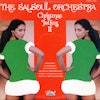After a rather combative interview with Teddy Pendergrass for Wax Poetics 33, I was often asked, “What was up with Teddy that day?” To say that we butted heads would be an understatement. Teddy straight-up got at me, which was difficult to accept from someone I admired for so many years. While Michael Jackson was the first artist that garnered my independent support, it was Pendergrass’s music that I was raised on. If you lived in an African American household at any point during the 1970s, then Philadelphia International Records (PIR) most likely provided the soundtrack to your life. And at Philly International, Pendergrass was king. Theodore DeReese Pendergrass was fifty-nine at the time of his death from complications of colon cancer.
“Teddy had a hot head,” says Kenny Gamble, cofounder of PIR along with Leon Huff. “I think that was part of his attraction—that he was a little arrogant—which was good, because he was very sure of himself.” Such certainty led a ten-year-old Pendergrass to his first calling as an ordained minister, and then to a life in music, where he began his career as a drummer. The teenage Pendergrass was a regular on the Philadelphia club circuit until his first break came when asked to tour with singer “Little” Royal Torrance (of Little Royal and the Swingmasters fame). After his time with Torrance, Pendergrass began playing with a local act called the Cadillacs until receiving the career break as the Cadillacs were folded into the Harold Melvin–helmed Blue Notes in 1969.
In just a year, Pendergrass moved from behind the drum kit to lead vocalist, eventually becoming a featured performer on the strength of his unparalleled singing ability. Says Gamble: “Teddy had the ability to sing smooth, and then he had the power to sing rough. He’d change up on you in a minute in the studio. He was an artist that had it all going for him.
“He was unique in a way. I put him in the same category that you put Jackie Wilson, and Sam Cooke, and Marvin Gaye, and Otis Redding. He was one of those types of artists.” As a member of Harold Melvin and the Blue Notes, Pendergrass sang lead on a string of R&B classics—“The Love I Lost,” “Bad Luck,” “If You Don’t Know Me by Now,” “Wake Up Everybody”—before embarking on a solo career in 1976.
“He was very intelligent,” says Gamble. “He wasn’t just a singer. He was very, very intelligent, and he was a good businessman.” Pendergrass’s first four albums as a solo artist—Teddy Pendergrass (1977), Life Is a Song Worth Singing (1978), Teddy (1979), and TP (1980)—all went platinum, cementing his ’70s dominance. A March 1982 automobile accident would leave Pendergrass a quadriplegic and temporarily halt his recording career, but it wouldn’t extinguish his inner fire, which I found out that day.
“He would bark back at you,” Gamble adds, “but I never experienced that with him. We had a real good relationship. But people tell me all the time that he would bark at them a little bit, but I think his bark was a little stronger than his bite, you know? Because Teddy would do anything for you.
“Teddy was very loyal to Gamble and Huff, and as a recording artist, he was probably one of the best that we ever worked with.”
Out of nine lives, Teddy had at least fourteen that I know of. Shep Gordon and I started managing Teddy in 1978, and through the almost thirty-two years, we witnessed such tenacity from him. We saw someone who could suffer and keep his head up high; we learned that greatness is a gift, not a right; and we learned that we should appreciate everything we have now, because it can be lost in a moment. Often imitated—but I can say as a consistent witness, never duplicated—he rode Gamble and Huff songs like Ben-Hur in the Circus Maximus. He could give life to any song he sang. I say all this because being an artist was a very important role to Teddy, and he never faltered in it, he never phoned it in, and he gave it everything he had, in life as in death.
–Funeral remarks of manager Daniel S. Markus, January 23, 2010

